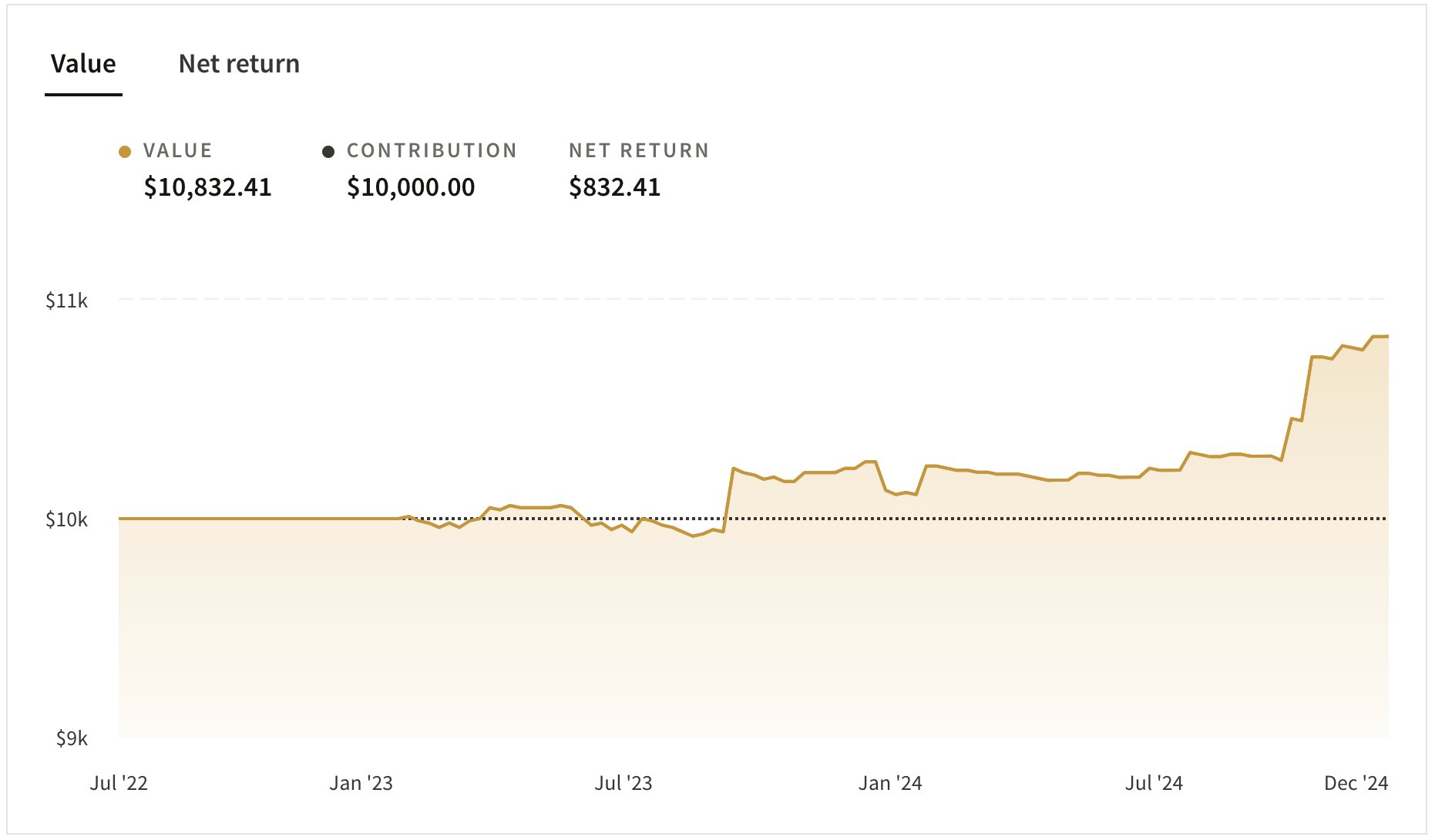Fundrise Innovation Fund Review 2025

The world of private markets continues to open up for retail investors.
Notably, you can now invest in many of the world's top private tech companies via Fundrise's Innovation Fund, a venture capital fund that's accessible to all investors.
The fund invests in a diverse portfolio of AI, machine learning, data infrastructure, and other categories. Its current holdings include Anthropic, Databricks, and (most recently) OpenAI.
An investment in the fund gives you exposure to all of these companies — and many others — in a single investment.
However, as the Innovation Fund is relatively new, you may be wondering about its track record, legitimacy, and investment strategy.
In this review, I cover how the fund works, which companies it's invested in, how it's performed, and more, as well as whether it's worth an investment.
Innovation Fund review summary
- Overall rating:
- Service type: Venture portfolio
- Availability: Open to all U.S. residents
- Best for: Long-term, risk-tolerant investors
- Fees: 1.85% annual management fee
In my opinion, the Innovation Fund is the best and easiest way for retail investors to gain access to a diverse portfolio of private technology companies.
Plus, the minimum investment is just $10.
However, venture capital investing is risky — many VC-backed companies never generate positive returns for investors. Additionally, the fund is only about two years old and has a limited track record of performance.
If you can accept these risks and want to allocate some portion of your investment portfolio to venture investments, the Innovation Fund could be a great option for you.
Disclosure: I'm an investor in the Innovation Fund.
What is Fundrise?
Fundrise is an investment platform that gives regular investors access to residential and commercial real estate, private credit, and (now) venture capital investments.
The company was founded in 2010 by brothers Ben and Dan Miller, real estate developers who wanted to create a way for individual investors to invest in their projects.
Their first project raised $325,000 from 175 investors, making it the first crowdfunded real estate project in the United States.
Today, more than 2.1 million investors have invested over $7 billion on the platform.
Users can invest in all three private asset classes (real estate, private credit, and venture capital) from the same account, which makes it easy to track contributions and returns.
I've found both the website and the mobile app to be very user-friendly, and I have set up the platform's recurring investment feature to make regular contributions to my Fundrise portfolio.
If you're a retail investor (or an accredited investor) and are looking for one platform to allocate some of your portfolio into alternative assets, Fundrise should be at the top of your list.
What is the Innovation Fund?
Fundrise's Innovation Fund is a venture capital fund for all investors.
The Innovation Fund is an evergreen or permanent fund, meaning it will continuously raise capital, make investments, and distribute capital over time.
In contrast, many VC funds raise capital over a 2–3 year period, invest for a year, wait and return capital after 5–10 years, close the fund, and then repeat the process with a new fund.
The goal of the fund is to deliver long-term growth for investors by investing in a diverse portfolio of private, high-growth technology companies.
While the fund primarily invests in late-stage businesses that are nearing their IPOs, it also holds early-stage startups. The fund may also hold companies even after they IPO and become publicly traded.
The fund owns companies in several thematic sectors, including artificial intelligence, machine learning, data infrastructure, software providers, and other categories with favorable macroeconomic tailwinds and attractive long-term growth potential.
The fund was established in July 2022. You can read about its performance and its current holdings below.
Investment strategy
Due to the nature of private, venture-backed, high-growth technology companies, you should expect that returns may vary substantially over the near term. And, as a result, the Fund is intended only for long-term investors who understand the risks associated with illiquid investments.
The fund's managers list 5 “investment strategy drivers” for the Innovation Fund:
1. Waves of technology breakthroughs
The team believes there are many industries where software has yet to be integrated.
For these industries, real estate included, there are large productivity gains and cost savings waiting to be captured by integrating software into companies' workflows.
The team wants to invest in the companies providing this new software.
2. Tech companies staying private for longer
Companies like Amazon, Apple, and Microsoft went public much earlier in their lifecycles than companies today because it was the only way to raise capital.
Today, the best private businesses are able to raise the capital they need from the private markets without the additional cost and complexity of public reporting.
Unfortunately, this eliminates the opportunity for individual investors to participate during a high growth phase of a company's lifecycle.
3. Thematic focus
The team is focused on a few categories where they believe there are the strongest macro tailwinds.
These include artificial intelligence (AI) and machine learning (ML), data infrastructure, vertical and horizontal software, and property technology (PropTech).
These themes aren't set in stone, however, and the team will continuously re-evaluate the macro environment and position the portfolio accordingly.
4. Private index approach
The team wants to build a broad portfolio of private companies to diversify risk and increase the probability of picking large winners.
While riskier than investing in public companies, the team believes that once a private tech company reaches a certain stage, it's possible to identify a subset of businesses with the strongest fundamentals.
By investing across a large portion of them (like indexing the Nasdaq-100), they expect to produce superior returns over the long term.
5. Opportunistic tech investing
The team is flexible, allowing them to pivot quickly and take advantage of changing market conditions or opportunistic valuations.
My takeaway
I appreciate that the fund managers have outlined a very specific “sandbox” from which they make investments.
Having this narrow focus should allow for them to have a greater understanding of the companies in that predetermined field of vision and the ability to act more quickly when an investment opportunity presents itself.
It also gives the fund's investors insight into what types of companies will be added in the future.
Which companies does the fund own?
Currently, the portfolio is split between several industries:
- Modern data infrastructure: 53.1%
- Artificial intelligence & machine learning: 19.4%
- Real estate & property technology: 5.7%
- Financial technology: 0.7%
- Other: 21.2%
The fund makes two types of investments: equity and corporate bonds.
While the main focus is on taking equity stakes in private companies, the fund may invest in corporate bonds of public companies to generate a return for and provide liquidity for investors.
Here's a breakdown of the fund's current holdings (newest investments listed first):
| Company | Investment type | Industry |
| Hightouch | Equity | Modern data infrastructure |
| Ramp | Equity | Financial technology |
| Omni | Equity | Modern data infrastructure |
| OpenAI | Equity | Artificial intelligence & machine learning |
| Anthropic | Equity | Artificial intelligence & machine learning |
| Anduril Industries | Equity | Other |
| Anyscale | Equity | Artificial intelligence & machine learning |
| dbt Labs | Equity | Modern data infrastructure |
| Canva | Equity | Other |
| Jetty | Equity | Real estate & property tech |
| Databricks | Equity | Modern data infrastructure |
| Inspectify | Equity | Real estate & property tech |
| ServiceTitan | Equity | Other |
| Immuta | Equity | Modern data infrastructure |
| JAMF | Corporate bonds | Other |
| Theory Ventures | Equity | Artificial intelligence & machine learning |
| Uber | Corporate bonds | Other |
| Match | Corporate bonds | Other |
| Splunk | Corporate bonds | Modern data infrastructure |
| Elastic | Corporate bonds | Modern data infrastructure |
| ZoomInfo | Corporate bonds | Artificial intelligence & machine learning |
| Twilio | Corporate bonds | Development operations |
| Vanta | Equity | Modern data infrastructure |
As you can see, the company has been able to take more equity stakes recently, a trend I expect to continue as the team becomes more experienced and is able to make larger investments.
The fund's performance to date
Because private companies only receive new valuations when they raise additional rounds (which typically happens once every few years), it's common for venture funds to have long periods of little to no fluctuations in price.
As you can see in the chart below, the fund's value hadn't seen much fluctuation since its inception in July 2022 until the end of 2024.
Three of the fund's holdings — OpenAI, Databricks, and Canva — all had valuation increases between October and December 2024. Another holding, ServiceTitan, also had its IPO.
As a result, the total net return of the fund jumped to 8.32%:
Source: Fundrise
The net return over this 2.5-year period was $832.41 (made up of $810.88 in price appreciation and $21.52 in distributions), or 8.32%. That's an annualized return of ~3.33%.
These returns are net of fees, which are discussed in further detail in the section below.
Innovation Fund fees
The Innovation Fund charges a 1.85% annual management fee on the total amount of assets you have invested in the fund.
For example, a $10,000 investment would be charged $185 per year.
This fee is low compared to industry standards. Most venture capital firms use a 2-and-20 structure where they charge a 2% annual fee plus a 20% fee on any profits generated (known as “carry”).
Pros and cons
| Pros | Cons |
| Access to private, VC-backed technology companies | Venture investing is risky |
| Available to all investors (U.S. residents only) | Limited track record |
| Minimum investment of $10 | |
| Easy sign-up process (can make your first investment in < 5 minutes) |
Is the Fundrise Innovation Fund legit?
Yes, the Innovation Fund is legit.
The fund is publicly registered with the SEC under the Investment Company Act of 1940 as a non-diversified, closed-end management investment company that is operated as a tender offer fund.
As mentioned above, Fundrise has been around since 2010 and has invested more than $7 billion on behalf of over two million investors. The Innovation Fund has $153 million of net asset value (NAV).
Regarding security, Fundrise uses bank-level security to protect your personal information. Your information is encrypted with an AES bit symmetric key, the same level of encryption used by the largest commercial banks.
Fundrise applications and data are physically located in multiple secure data centers, and the company utilizes Amazon Web Services (AWS) for its hosting, which is compliant with numerous security certifications.
However, its investments (like all investments) involve risk and may result in partial or total loss of funds.
Final verdict
So, should you invest in the Innovation Fund?
If you're a retail investor and you:
- Want to allocate some percentage of your portfolio (like 5–15%) to a collection of private, VC-backed tech startups,
- Can stomach the risk, lack of liquidity, and near-term fluctuations, and
- Are willing to accept the 1.85% annual management fee,
the Innovation Fund may be a great option for you.
Personally, I've decided to allocate 3–5% of my portfolio to it for now and may increase the percentage over time. I want exposure to the companies it's investing in and I am comfortable with the risk of losing some or all of my capital.
This is my personal opinion, and what I've decided is right for me. It is not investment advice.
You should do your own due diligence and decide for yourself if the fund is an appropriate investment for your portfolio.





.png)

